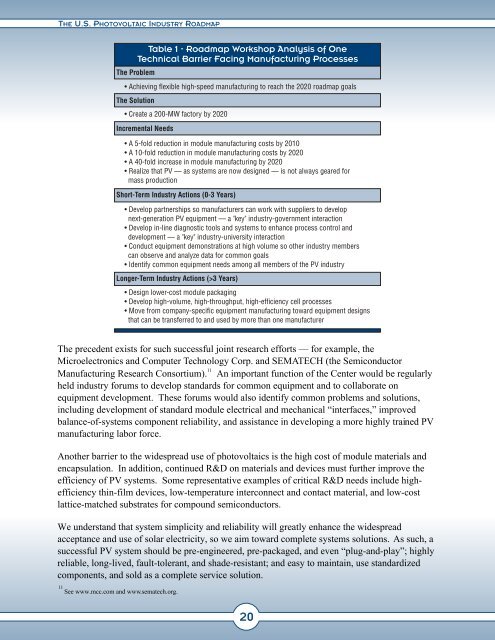Solar Electric Power -- The U.S. Photovoltaic Industry ... - Ecotopia
Solar Electric Power -- The U.S. Photovoltaic Industry ... - Ecotopia
Solar Electric Power -- The U.S. Photovoltaic Industry ... - Ecotopia
You also want an ePaper? Increase the reach of your titles
YUMPU automatically turns print PDFs into web optimized ePapers that Google loves.
THE U.S. PHOTOVOLTAIC INDUSTRY ROADMAP<br />
<strong>The</strong> Problem<br />
• Achieving flexible high-speed manufacturing to reach the 2020 roadmap goals<br />
<strong>The</strong> Solution<br />
Table 1 - Roadmap Workshop Analysis of One<br />
Technical Barrier Facing Manufacturing Processes<br />
• Create a 200-MW factory by 2020<br />
Incremental Needs<br />
• A 5-fold reduction in module manufacturing costs by 2010<br />
• A 10-fold reduction in module manufacturing costs by 2020<br />
• A 40-fold increase in module manufacturing by 2020<br />
• Realize that PV — as systems are now designed — is not always geared for<br />
mass production<br />
Short-Term <strong>Industry</strong> Actions (0-3 Years)<br />
• Develop partnerships so manufacturers can work with suppliers to develop<br />
next-generation PV equipment — a "key" industry-government interaction<br />
• Develop in-line diagnostic tools and systems to enhance process control and<br />
development — a "key" industry-university interaction<br />
• Conduct equipment demonstrations at high volume so other industry members<br />
can observe and analyze data for common goals<br />
• Identify common equipment needs among all members of the PV industry<br />
Longer-Term <strong>Industry</strong> Actions (>3 Years)<br />
• Design lower-cost module packaging<br />
• Develop high-volume, high-throughput, high-efficiency cell processes<br />
• Move from company-specific equipment manufacturing toward equipment designs<br />
that can be transferred to and used by more than one manufacturer<br />
<strong>The</strong> precedent exists for such successful joint research efforts — for example, the<br />
Microelectronics and Computer Technology Corp. and SEMATECH (the Semiconductor<br />
11<br />
Manufacturing Research Consortium). An important function of the Center would be regularly<br />
held industry forums to develop standards for common equipment and to collaborate on<br />
equipment development. <strong>The</strong>se forums would also identify common problems and solutions,<br />
including development of standard module electrical and mechanical “interfaces,” improved<br />
balance-of-systems component reliability, and assistance in developing a more highly trained PV<br />
manufacturing labor force.<br />
Another barrier to the widespread use of photovoltaics is the high cost of module materials and<br />
encapsulation. In addition, continued R&D on materials and devices must further improve the<br />
efficiency of PV systems. Some representative examples of critical R&D needs include highefficiency<br />
thin-film devices, low-temperature interconnect and contact material, and low-cost<br />
lattice-matched substrates for compound semiconductors.<br />
We understand that system simplicity and reliability will greatly enhance the widespread<br />
acceptance and use of solar electricity, so we aim toward complete systems solutions. As such, a<br />
successful PV system should be pre-engineered, pre-packaged, and even “plug-and-play”; highly<br />
reliable, long-lived, fault-tolerant, and shade-resistant; and easy to maintain, use standardized<br />
components, and sold as a complete service solution.<br />
11<br />
See www.mcc.com and www.sematech.org.<br />
20


